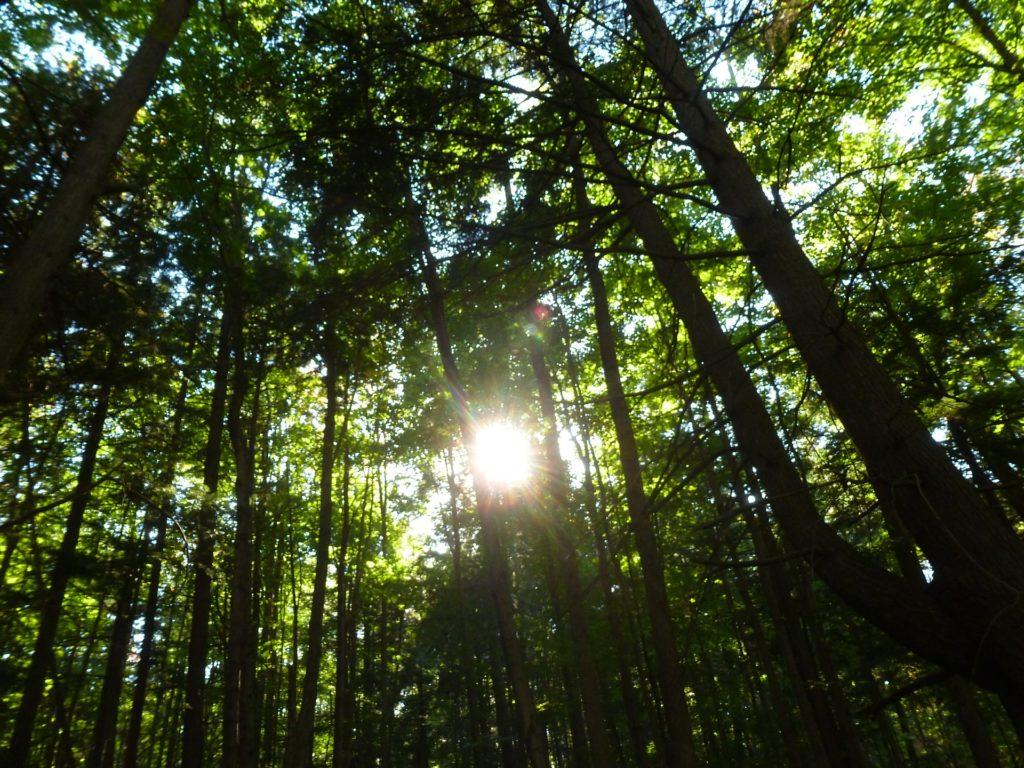Planting popular species of tree is a great thing to do, even if it sounds boring! This is because native trees are important for the general ecosystem, and in looking at what’s most common in your area, you’ll also get a good sense of what tree will thrive after planting.
If you’re having trouble picking out a sapling to plant, or need help identifying a tree in your neighbourhood, these five will probably be your best bet!
Sugar Maple
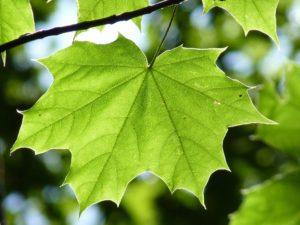 You may know this one – its leaf is on our national flag after all! There are many different types of maple, but the sugar maple is one of the most popular and plentiful, and not just because it has the best sap for syrup. The sugar maple is a keystone species in the Carolinian forests of eastern North America, and its health is vital to our ecosystem.
You may know this one – its leaf is on our national flag after all! There are many different types of maple, but the sugar maple is one of the most popular and plentiful, and not just because it has the best sap for syrup. The sugar maple is a keystone species in the Carolinian forests of eastern North America, and its health is vital to our ecosystem.
The sugar maple can live for more than 200 years, and can grow up to 35 metres tall in that time. In the fall, the yellow-green leaves of this maple turn a brilliant yellow, orange, or red, creating that riot of colour that makes fall so popular. It has smooth, gray bark that becomes darker as the tree gets older, splitting into small dark ridges. Seeds from the sugar maple are found in those “helicopter” key casings that seem to get everywhere!
White Oak
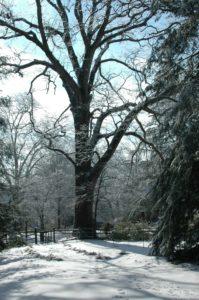 It’s probably better known to Londoners for lending its name to a local mall, but the white oak is a tree they probably see every day. This mighty oak can grow to over 35 metres in height, and it can thrive for hundreds years. The leaves turn a bright green on the outside and have an underbelly that is paler, and they’ll turn a purplish red before falling off in the autumn. Other than its stereotypical oak leaf shape, you can identify the white oak from its pale gray, almost white bark, which will usually have long scales running through it.
It’s probably better known to Londoners for lending its name to a local mall, but the white oak is a tree they probably see every day. This mighty oak can grow to over 35 metres in height, and it can thrive for hundreds years. The leaves turn a bright green on the outside and have an underbelly that is paler, and they’ll turn a purplish red before falling off in the autumn. Other than its stereotypical oak leaf shape, you can identify the white oak from its pale gray, almost white bark, which will usually have long scales running through it.
To the untrained eye, acorns might be the clearest identifier of the white oak. It takes a year for acorns to fully grow, and they’ll drop off when ripe. The acorns are a favourite food for animals like birds and squirrels, allowing it to spread far as they are excreted or stored away and forgotten.
White Birch
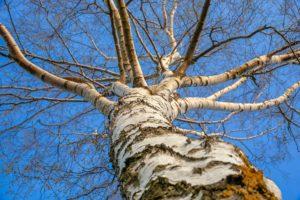 The classic cottage tree, white birches are found everywhere in Ontario just short of Hudson’s Bay, and it’s hardiness has made it a popular choice for landscapers, too. It’s not as big as the other commonly-found trees, but it can grow to 25 metres in height, with leaves about 5 to 10 centimetres in length. The tree’s trunk is its most immediate identifier, and this smooth, white covering peels off rather easily. While the bark is very tough yet pliable (making it a solid choice for canoe building), don’t peel too much off – this can kill the tree.
The classic cottage tree, white birches are found everywhere in Ontario just short of Hudson’s Bay, and it’s hardiness has made it a popular choice for landscapers, too. It’s not as big as the other commonly-found trees, but it can grow to 25 metres in height, with leaves about 5 to 10 centimetres in length. The tree’s trunk is its most immediate identifier, and this smooth, white covering peels off rather easily. While the bark is very tough yet pliable (making it a solid choice for canoe building), don’t peel too much off – this can kill the tree.
Buds, leaves and seeds from the white birch are a great source of food for birds and animals. The leaves of the white birch are oval-shaped, almost like an egg, with a dull green top and lighter green underneath.
Green Ash
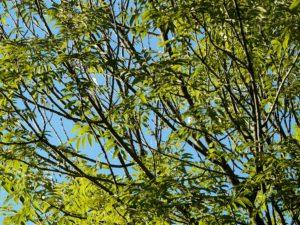 The green ash is a popular choice in residential areas, as it had a great shape to maximize shade. We should say was a popular choice, because an invasive species is posing a massive threat to ash trees just about everywhere they grow in North America: the Emerald Ash Borer. It’s a shame too, because the green ash produces a large amount of the small fruit that hold its seeds, making it a popular food for more animals than just the ash borer.
The green ash is a popular choice in residential areas, as it had a great shape to maximize shade. We should say was a popular choice, because an invasive species is posing a massive threat to ash trees just about everywhere they grow in North America: the Emerald Ash Borer. It’s a shame too, because the green ash produces a large amount of the small fruit that hold its seeds, making it a popular food for more animals than just the ash borer.
You can identify this tree by looking at its oval-shaped, yellow-green leaflets – they grow five to nine in a bunch on a stalk. It’s a medium-sized tree, growing no more than 25 metres tall, but it grows quickly. The bark of the green ash is a grey-brown colour. If you see small, penny-to-dime sized holes in the bark, that’s the sign the Emerald Ash Borer has found it.
Black Walnut
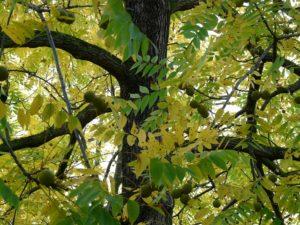 Prized for its wood, black walnut is a beautiful, dark tree favoured by both carpenters and animals. While it commonly grows in moist, soggy soil, the black walnut’s range is spreading, thanks to human planting and absent-minded squirrels who’ve forgotten where they’ve buried the fruit!
Prized for its wood, black walnut is a beautiful, dark tree favoured by both carpenters and animals. While it commonly grows in moist, soggy soil, the black walnut’s range is spreading, thanks to human planting and absent-minded squirrels who’ve forgotten where they’ve buried the fruit!
The fruit might be the best way to pick out a black walnut tree – they are round, fairly large, and a bright green (and have a very pungent odor). The tree can also be identified by its bark, which is thick with dark ridges. The leaflets grow sort of like the green ash, just with more of them – between 15 – 20 leaflets grow on each stalk.

